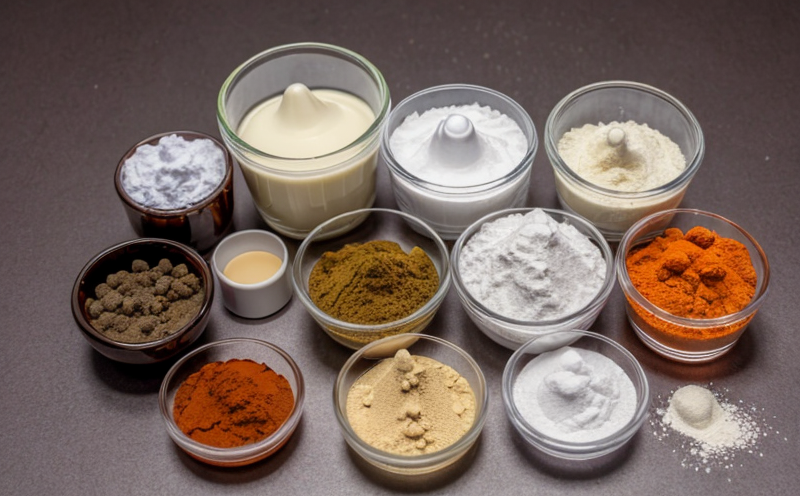Karl Fischer Titration Moisture Content Testing
In the pharmaceutical industry, excipients and formulation ingredients play a crucial role in ensuring product quality, safety, and efficacy. Among various analytical methods, Karl Fischer titration stands out as an indispensable tool for moisture content testing of these components. This technique is particularly suited for excipients due to its high precision and accuracy, especially when dealing with trace amounts of water.
The method relies on the reaction between sulfur dioxide (SO₂) and iodine in aqueous solution, which consumes a specific amount of titrant corresponding to the quantity of moisture present. The endpoint is determined by an electrical conductivity or potentiometric measurement, ensuring reliable results even for very low moisture levels.
Pharmaceutical excipients are often used in various forms such as powders, granules, and tablets, each requiring precise moisture content analysis. For instance, excipients like lactose monohydrate must be stored under controlled conditions to prevent hygroscopicity issues that could affect the stability of the final product. Karl Fischer titration allows quality managers to monitor these parameters accurately.
Moreover, this technique is widely used in research and development (R&D) for formulating new drug products. It helps R&D engineers understand how moisture content influences dissolution rates or compatibility with other ingredients during formulation design.
The precision of Karl Fischer titration makes it a valuable asset for pharmaceutical manufacturers aiming to comply with stringent regulatory requirements set by organizations like the U.S. FDA, European Medicines Agency (EMA), and International Conference on Harmonization (ICH). Compliance officers rely heavily on accurate moisture content data provided by this method to ensure adherence to Good Manufacturing Practice (GMP) guidelines.
In summary, Karl Fischer titration offers a reliable solution for measuring moisture content in excipients and other formulation ingredients. Its ability to provide precise measurements is critical for maintaining product quality throughout the supply chain, from raw material procurement to finished goods distribution.
Why It Matters
The importance of accurate moisture content measurement cannot be overstated when dealing with excipients and other pharmaceutical ingredients. Moisture can significantly impact drug stability, shelf life, and efficacy. Excessive water content in excipients like microcrystalline cellulose or sodium starch glycolate can lead to hygroscopicity, which might cause agglomeration or degradation of the active pharmaceutical ingredient (API). Conversely, insufficient moisture can result in poor flowability or compaction issues during manufacturing processes.
For quality managers and compliance officers, ensuring that excipients meet specified moisture content levels is not just a technical requirement but also a safety concern. Regulatory bodies worldwide emphasize the need for consistent product quality to protect public health. Non-compliance with these standards can lead to product recalls or even legal action.
From an R&D perspective, understanding how moisture affects the formulation process is essential for optimizing production efficiency and improving product performance. By using Karl Fischer titration, researchers can identify optimal storage conditions and processing techniques that minimize adverse effects of water content on drug stability and efficacy.
In conclusion, accurate moisture content testing through Karl Fischer titration is crucial for maintaining high standards in pharmaceutical manufacturing, ensuring compliance with international regulations, and delivering safe and effective medicines to consumers.
Applied Standards
The primary standard governing Karl Fischer titration in the context of pharmaceutical excipients is ISO 12735-4:2016. This international standard provides detailed guidelines on the method’s application, including sample preparation, reagent selection, and procedural steps to ensure accurate moisture determination.
ASTM E948-17 also offers complementary guidance for this technique, emphasizing its use in specific industries beyond just pharmaceuticals. While not exclusively focused on excipients, it reinforces the reliability of Karl Fischer titration across diverse applications.
Additionally, the ICH Q5C guideline provides recommendations for moisture content testing of active ingredients and excipients. Although primarily aimed at APIs, these principles can be extended to include excipients where appropriate. Compliance with such standards ensures that manufacturers are adhering to best practices recognized globally within the pharmaceutical sector.
International Acceptance and Recognition
Karl Fischer titration is widely accepted and recognized internationally for its accuracy and reliability in measuring trace amounts of moisture in excipients and other pharmaceutical ingredients. Its acceptance spans across various regulatory bodies, including those from the United States (FDA), Europe (EMA), Japan (Pharmaceuticals and Medical Devices Agency - PMDA), and China (NMPA).
Regulatory authorities often reference ISO standards when approving analytical methods used in drug development and manufacturing processes. The consistency provided by Karl Fischer titration supports harmonized testing protocols globally, making it easier for multinational pharmaceutical companies to standardize their quality control procedures worldwide.
The technique's robustness also extends beyond regulatory requirements; it is embraced by industry leaders as a cornerstone of good laboratory practice (GLP). Its universal applicability facilitates seamless integration into different organizational environments, ensuring consistent results regardless of location or facility type.
In summary, the international recognition and acceptance of Karl Fischer titration underscore its significance in maintaining high standards across all stages of pharmaceutical production. By adhering to these internationally recognized methods, manufacturers can ensure their products meet rigorous quality criteria demanded by global markets.





